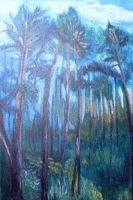Lately I’ve been thinking of the process of genealogy as a metaphor for understanding the pathways of one's own life, not just the lives of our ancestors. Just as with genealogy, we begin to understand and manage our path through life when we understand the way each step opens the door for new paths and how multiple paths can begin to weave together into a more powerful direction than any one path in isolation. The often innocuous discovery can lead to opportunity. Sometimes the opportunity is right in front of us, but we don’t recognize it until we are ready.
I am an “ incrementalist” by nature, realizing that the big stuff grows out of many little steps. And perhaps I am more focused on this than most, going so far as to keep a spreadsheet of steps taken and what they lead to.
Let me give you an example…Recently I was invited to show my artwork on Radom, Poland at the arts and culture center in the city of Radom. I’ve had many people ask how that came about and I realize there is no simple answer, multiple threads connected to create that opportunity. Just as I often retrace my steps in genealogy to understand how I solved the puzzle, I began to retrace my steps in life.
In actuality it started over five years ago when I tracked down a second cousin in Israel. His daughter who spoke English became my point of connection. When she was going to a conference in Montreal, I flew up to Montreal to meet her. There I also met her cousin who is head of the Radom Society, the organization for survivors and children of survivors of Radom who live in Montreal.
And another thread…Early this year I developed the Shtetlink for Radom, Poland. The Shtetlink is a website for Jewishgen.org that is created to help others researching family from that town. In developing the site, I connected with people all over the world sending out 400 e-mails to fellow researchers. One Israeli friend provided me with a homemade film of the Jewish community of Radom that dated to 1937, five years before that community was annihilated. In taking stills from the film for the website, I realized its potential as source material for artwork. That same friend connected me with the arts and culture center when I was planning a trip to Radom. They very kindly assisted me in getting the key to the cemetery as well as providing photos for the website.
I’ve been working on a series of artwork on Radom, but feeling the need for story to breathe life into it. My work typically is a vehicle to tell a story and while the Radom work captures a picture of the former Jewish community, it needed more. I do quite a bit of public speaking and it was through an arts connection who heard me speak that I was introduced to a woman in my community who is a survivor from Radom. She has graciously agreed to let me interview her and incorporate her memories with my artwork.
So we have the website, source material feeding into a body of artwork, a survivor’s story, a connection in Radom and a connection in Montreal. Now we have only to set it in motion. I have a mental image of a pinball machine shooting the ball forward. A month ago I received an e-mail from the head of the Montreal Radom Society telling me about a new development in Radom. I’ve written about it in this blog at An Unusual Collaboration , but essentially it was the discovery of 70 previously unknown Jewish tombstones that had been hidden away and are now incorporated into a monument, that had recently been dedicated.
Now to appreciate this fully you must realize that the Nazis used many of the Radom tombstones to pave the roads, not only destroying the synagogue and the people, but also destroying the history of past Jewish families as reflected in the cemetery. I promptly decided I needed to get pictures of the tombstones for the Shtetlink, but how to do so? An e-mail to my contact at the arts and culture center soon secured their agreement to send me photos. Of course, I also shared with them the link to my artwork on Radom and the story of my interviewing the survivor. They quickly responded with a request that I consider showing my work in April when they do a focus on the former Jewish community of Radom.
And that is how things happen.

























